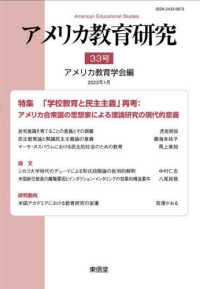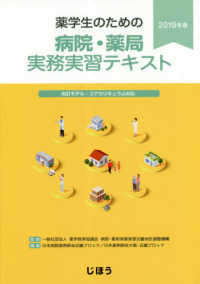基本説明
Fully revised and streamlined to include the most recent information, provides students with the theory and application knowledge necessary to fully prepare them for the highly specialized and complicated technical world of critical care nursing. Previous ed.: 2008.
Full Description
Fully revised and streamlined to include the most recent information, Critical Care Nursing: A Holistic Approach , 10e provides students with the theory and application knowledge necessary to fully prepare them for the highly specialized and complicated technical world of critical care nursing.These specially designed features assist students in providing competent and compassionate care to critically ill patients and their families:* NEW!! Evidence-Based Practice Highlights focus attention on the importance of research-based practice and include significant excerpts from AACN practice alerts as well as guidelines from other relevant organizations.* NEW!! Icons to identify drug therapy tables as well as laboratory and diagnostic tables focus attention on significant information.* NEW!! Spotlight on Genetics box, appearing in selected chapters, is key to understanding how genetic factors influence disorders.NEW!! Patient Safety boxes guide safe and effective practice by alerting the critical care nurse of risk factors, signs and symptoms, side effects, and complications.* Considerations for the Older Patient boxes highlight the special needs of the fastest growing part of our population - older patients.* Health History boxes summarize key areas that should be covered and relevant information that may be revealed during the health history.* Collaborative Care Guides, presented in a tabular format containing outcomes and interventions, describe how the health care team works together to manage a patient's illness and minimize complications.* Teaching Guides help the critical care nurse to prepare patients and family members for procedures, assist patients and family members with understanding the illness they are dealing with, explain post-procedure or postoperative activities, or prepare a patient for discharge from the hospital.* Nursing Diagnoses boxes use current NANDA terminology to summarize common nursing diagnoses for particular conditions.Nursing Interventions tables and boxes highlight key information for the critical care nurse
Contents
Part 1 The Concept of Holism Applied to Critical Care Nursing Practice1 Critical Care Nursing Practice: Promoting Excellence Through Caring, Collaboration, and Evidence2 The Patient's Experience With Critical Illness3 The Family's Experience With Critical Illness4 Patient and Family Education in Critical Care5 Relieving Pain and Providing Comfort6 Palliative Care and End-of-Life Issues in Critical CarePart 2 Professional Practice Issues in Critical Care7 Ethical Issues in Critical Care Nursing8 Legal Issues in Critical Care Nursing9 Building a Professional Practice Model for Excellence in Critical Care NursingPart 3 Special Populations in Critical Care10 The Critically Ill Pediatric Patient11 The Critically Ill Pregnant Woman12 The Critically Ill Older Patient13 The Postanesthesia PatientPart 4 Special Situations in Critical Care14 Rapid Response Teams and Transport of the Critically Ill Patient15 Disaster Management: Implications for the Critical Care NursePart 5 Cardiovascular System16 Anatomy and Physiology of the Cardiovascular System17 Patient Assessment: Cardiovascular System18 Patient Management: Cardiovascular System19 Common Cardiovascular Disorders20 Heart Failure21 Acute Myocardial Infarction22 Cardiac SurgeryPart 6 Respiratory System23 Anatomy and Physiology of the Respiratory System24 Patient Assessment: Respiratory System25 Patient Management: Respiratory System26 Common Respiratory Disorders27 Acute Lung Injury and Acute Respiratory Distress SyndromePart 7 Renal System28 Anatomy and Physiology of the Renal System29 Patient Assessment: Renal System30 Patient Management: Renal System31 Renal FailurePart 8 Nervous System32 Anatomy and Physiology of the Nervous System33 Patient Assessment: Nervous System34 Patient Management: Nervous System35 Common Neurosurgical and Neurological Disorders36 Traumatic Brain Injury37 Spinal Cord InjuryPart 9 Gastrointestinal System38 Anatomy and Physiology of the Gastrointestinal System39 Patient Assessment: Gastrointestinal System40 Patient Management: Gastrointestinal System41 Common Gastrointestinal DisordersPart 10 Endocrine System42 Anatomy and Physiology of the Endocrine System43 Patient Assessment: Endocrine System44 Common Endocrine DisordersPart 11 Hematological and Immune Systems45 Anatomy and Physiology of the Hematological and Immune Systems46 Patient Assessment: Hematological and Immune Systems47 Organ and Hematopoietic Stem Cell Transplantation48 Common Immunological Disorders49 Common Hematological DisordersPart 12 Integumentary System50 Anatomy and Physiology of the Integumentary System51 Patient Assessment: Integumentary System52 Patient Management: Integumentary System53 Burns and Common Integumentary DisordersPart 13 Multisystem Dysfunction54 Shock, Systemic Inflammatory Response Syndrome, and Multiple Organ Dysfunction Syndrome55 Trauma56 Drug Overdose and PoisoningAppendix: ACLS Guidelines








